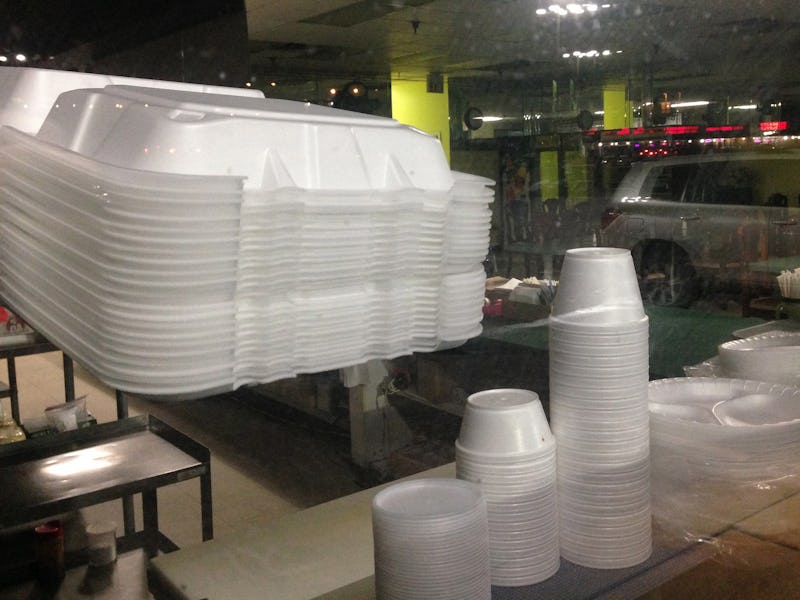It's High Time to Put Restaurant Styrofoam in the Historical Landfill
The options for compostable or recyclable dinner and tableware are, finally, affordable.

You walk into a well-reviewed Cajun-Creole fast-casual restaurant and order red beans and rice and drunken chicken. Eight hundred calories and innumerable beads of sweat later, you discover, to your delight, that the meal is too big to finish in one go. Impressing yourself with a show of self-control, you decide to stop eating and put the rest in a box.
But the box! The box is a real downer. You’re handed Styrofoam, something that, when its meager role has been served, will sit in a landfill for something like 500 years without biodegrading.
Indeed, Recycling Revolution makes the case that one-third of every dump is made up of packaging material. And since America is now not only throwing trash away but selling it to China and buying it back in the form of other trash, now is the time to consider a world without plastic-and-foam takeout.
Restaurant owner John M. has made that first step. He manages a fast-casual Cajun-Creole restaurant in a Midwest metropolis like the one imagined above — except he’s gotten rid of Styrofoam and changed all his take-out boxes over to Darnel, a 100 percent recyclable tableware and plasticware company based in Miami.
“And they’re great,” John tells me. “A clean, green alternative.” Switching was hard, but necessary, “especially since we do about 40 percent of our business in takeout.”
Recounting why he made the switch, John concedes that it was public pressure that got him thinking of going from Styrofoam to sustainable. A civil engineering student came in who just wilted when he saw he was getting his takeout in ‘foam. I love your food, he told the staff, but I can’t support that. Fair enough. John says costs for packaging went up “a little bit” with the changeover, but that being in a town with such a big student population made it necessary.
“I’m a blue-collar guy from central Indiana,” he says. “What do I know about ‘sustainable packaging’? But when I looked into it, it was a no-brainer.”
Interestingly, John asked that his last name, and the name of his restaurant, be withheld because he’s part of a chain of restaurants, all of whose locations didn’t transfer over to sustainable packaging. That sounds like the, ahem, inverse of how it ought to be be. Companies should celebrate moving to sustainable packaging, not cover up, right?
Consumer pressure is “probably the number one driver” of a business’s decision to switch to sustainable packaging, according to Adam Gendell, a project manager of the Sustainable Packaging Coalition, along with brand image, marketing, and risk mitigation. “A company doesn’t want organizations like Greenpeace coming after them” for the packaging methods they use, he says.
The Sustainable Packaging Coalition is an industry membership group, meaning it’s funded by dues from some 150 members, including companies like Keurig, Dow Chemical Company, and a number of universities. “Industry pays us to think like environmentalists,” Gendell says. “We work from 100,000 feet in the air,” advising companies on the sustainable options available to them without showing preference for any one approach.
Mr. Gendell contests the assumption that switching to compostable or recyclable tableware is cost-prohibitive.
“It won’t save any company’s bottom line, and they won’t go broke, either,” he says. “The options are out there. It’s all about locking in the right supplier, the right agreement and the right timeframe.”
The numbers back him up. Darnel products, the compostable and recyclable food storage container manufacturer to which John’s restaurant switched, sells a 200-pack of hinged lid all-purpose containers for $17.63 a pop.
For comparison, the absolute cheapest comparable styrofoam goes for $14/case, and many other styrofoam options can sell for $16 per case or more.
But the spark has to come from us, as consumers, agitating for change, spending our dollars politically, and not taking “it’s too expensive” for an answer. It helps to be informed, but it’s also as simple as asking, before you order takeout, “Do you use styrofoam?” If the answer is yes, tell them the sustainable options have gotten competitive.
Or just take your money elsewhere. A styrene-less world is one worth advocating for. That omelette you couldn’t finish, while great, shouldn’t linger on in earthly memory another 500 years.